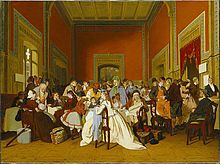Carl d'Unker

Carl Henning Lützow d'Unker , also Karl d'Uncker (born February 3, 1828 in Stockholm , † March 23, 1866 in Düsseldorf ), was a Swedish - German painter from the Düsseldorf School of Painting , whose work is characterized by socially critical genre painting .
Life
D'Unker was the son of the Norwegian cavalry master and chamberlain Carl Henning d'Unker (also Carl Henning Lützow Dunker, 1798–1863, 1828 adjutant to King Karl XIV. Johann ) and his Swedish wife Annette Christiane, née Brunstedt († 1870) . Determined for a military career, he joined the Royal Swedish Life Guard . As a Danish officer, he took part in the Schleswig-Holstein War in 1848 . Shortly afterwards he returned to Sweden and turned to art. The Swedish King Oskar I , who was deeply impressed by the "Nordic painting" of the Norwegians August Cappelen , Adolph Tidemand and Hans Fredrik Gude, who had trained in Düsseldorf and wanted to establish a corresponding Swedish painting, sent d'Unker to the art academy in 1850 with a travel grant Dusseldorf . He personally explained to his scholarship holder that Düsseldorf was the place "that seemed to him the best for beginners".
There d'Unker was the first Swedish painter, who was soon followed by others, such as Kilian Zoll , Marcus Larson , Edvard Bergh , August Malmström , Bengt Nordenberg , August Jernberg , Alfred Wahlberg and Mårten Eskil Winge . In the academy he studied with Karl Ferdinand Sohn between 1851 and 1853 . After a year-long stay in Sweden, d'Unker returned to Düsseldorf in 1854. In 1856 he went to study with Benjamin Vautier in Paris , where they met Ludwig Knaus , with whom they had shared a studio in Düsseldorf and who had a common interest in genre painting. On June 25, 1859, he married Clara Schnitzler, the daughter of the Düsseldorf architect Anton Schnitzler , who gave birth to his son Detlev Wilhelm Albert in 1864. A disease of the right arm forced d'Unker to paint left-handed since 1861. In 1865 he took part in the Salon de Paris together with other painters from Düsseldorf . Because of his untimely death in 1866, d'Unker was unable to take up the management of an art school in Gothenburg offered to him by the collector and wholesale merchant Bengt Erland Dahlgren .
plant
Instead of turning to Nordic subjects, d'Unker was particularly interested in the socio-critical and psychological description of the milieu based on the model of Johann Peter Hasenclever . In this profession he became "one of the most original and important Swedish genre painters of his century" (Ulf Abel).
Works d'Unker (selection) are:
- Old Woman with a Rosary (1853)
- Three town musicians playing (1853)
- Circus performers (1857)
- Violinist (1859)
- At the pawnbroker's (second version, 1859)
- At the pawnbroker's (fifth version, 1860)
- Man in front of the shop window (1864)
- The Wiesbaden gaming room (1864)
- Gypsy family in prison (1864)
- Second class waiting room (approx. 1865)
- Third class waiting room (1865)
literature
- Wend von Kalnein (ed.): The Düsseldorf school of painting . The same thing about it: Düsseldorf's influence on painting outside Germany . Verlag Philipp von Zabern, Mainz 1979, ISBN 3-8053-0409-9 , p. 197 ff.
- Ulf Abel: Düsseldorf and Swedish painting in the 19th century . Publication by G. Paffrath Gallery, Düsseldorf 1978.
- Eskil Cronlund: Carl d'Unker 1828–1866 . Lund 1942.
Web links
- Carl Henrik d'Unker . Auction results in the portal artnet .de
Individual evidence
- ^ Georg Nordensvan : Swedish art of the 19th century . EA Seemann, Leipzig 1904, p. 52
- ↑ D'Uncker (D'Unker), Karl Henning Lutzow . In: Theodor Westrin (Ed.): Nordisk familjebok konversationslexikon och realencyklopedi . 2nd Edition. tape 6 : Degeberg-Egyptolog . Nordisk familjeboks förlag, Stockholm 1907, Sp. 1066-1067 (Swedish, runeberg.org ).
- ↑ Bettina Baumgärtel, Sabine Schroyen, Lydia Immerheiser, Sabine Teichgröb: Directory of foreign artists. Nationality, residence and studies in Düsseldorf . In: Bettina Baumgärtel (Hrsg.): The Düsseldorf School of Painting and its international impact 1819–1918 . Vol. 1, Michael Imhof Verlag, Petersberg 2011, ISBN 978-3-86568-702-9 , p. 429
- ^ Hector Boeck: Norske, Svenske og Finske Frivillige Officerer og Læger i Den Danske Hær og Flaade i Krigene 1848–50 og 1864 . In: Personalhistorisk Tidsskrift , edition of February 10, 1935, pp. 214–264
- ^ Wend von Kalnein : The influence of Düsseldorf on painting outside of Germany . In: Wend von Kalnein (Ed.): The Düsseldorf School of Painting . Verlag Philipp von Zabern, Mainz 1979, ISBN 3-8053-0409-9 , p. 199.
- ↑ Sören Engblom: Modern Art D'Uncker (D'Unker), Karl Henning Lützow ( Memento of the original from January 26, 2009 in the Internet Archive ) Info: The archive link was automatically inserted and not yet checked. Please check the original and archive link according to the instructions and then remove this notice. sverige.de; Retrieved December 9, 2012
- ^ Three town musicians at play (1853) in the portal van-ham.com ; Retrieved December 17, 2012
- ↑ violinist (1859) in the van-ham.com portal ; Retrieved December 17, 2012
| personal data | |
|---|---|
| SURNAME | D'Unker, Carl |
| ALTERNATIVE NAMES | D'Unker, Carl Henning Lützow (full name); D'Uncker, Karl |
| BRIEF DESCRIPTION | Swedish-German painter from the Düsseldorf School of Painting |
| DATE OF BIRTH | February 3, 1828 |
| PLACE OF BIRTH | Stockholm |
| DATE OF DEATH | March 23, 1866 |
| Place of death | Dusseldorf |



